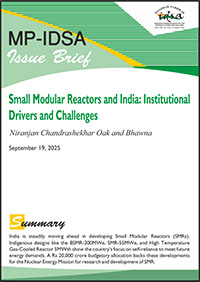Small Modular Reactors and India: Institutional Drivers and Challenges
- September 19, 2025 |
- Issue Brief
Summary
India is steadily moving ahead in developing Small Modular Reactors (SMRs). Indigenous designs like the BSMR-200MWe, SMR-55MWe, and High Temperature Gas-Cooled Reactor 5MWth show the country’s focus on self-reliance to meet future energy demands. A Rs 20,000 crore budgetary allocation backs these developments for the Nuclear Energy Mission for research and development of SMR.
Introduction
In the address to the nation from the ramparts of the Red Fort on the 79th Independence Day, Prime Minister Narendra Modi reiterated the nation’s aspirations to increase the share of nuclear energy tenfold by 2047.[1] The prime minister’s pronouncement was backed by a solid Rs 20,000 crore budgetary allocation for the Nuclear Energy Mission for research and development of Small Modular Reactors (SMR), in the financial year 2025–2026 budget. These allocations seek to activate at least five indigenously developed SMRs by 2033.[2]
Further, the budget set the ambitious target of 100 GW of nuclear energy by 2047. To facilitate private participation, the budget laid out plans to amend the Atomic Energy Act (AEA) of 1962 and the Civil Liability for Nuclear Damage Act (CLNDA) of 2010. The brief explores the ongoing efforts India is putting into the field of SMRs. Further, it analyses the importance of SMRs for India, the public and private sector drivers in the domain, and the challenges India has to overcome to achieve the full potential of SMRs.
India’s Indigenous Models of SMRs
According to the International Atomic Energy Agency (IAEA), SMRs typically produce nuclear energy up to 300 MWe per module. For the Department of Atomic Energy (DAE), the SMR’s capacity may range from less than 30 MWe to 300+ MWe. The DAE is designing and developing three SMR models: the Bharat Small Modular Reactor (BSMR) 200MWe, SMR 55mwe, and High Temperature Gas-Cooled Reactor.
The concept design of the BSMR-200MWe is indigenously developed by the Bhabha Atomic Research Centre (BARC) and Nuclear Power Corporation of India Limited (NPCIL). It is based on the Pressurised Water Reactor (PWR) technology and has passive and engineered safety features.[3] The BSMR model is slated to utilise Slightly Enriched Uranium (SEU) as fuel. The detailed engineering work for BSMR is underway, with the demonstration unit expected to be erected and started up within six years of financial approval, followed by commissioning and regular operation in the seventh year at an estimated cost of Rs 5,700 crores.[4] The project focuses on indigenous development and the role of private nuclear vendors in delivering various equipment and components.
The SMR-55MWe is also modelled on the PWR technology, featuring a block-type, highly modular design. The lead twin units of the reactor are planned to be set up at the DAE site by 2033.[5] The SMR-55MWe is being developed to deploy it in remote locations. Its small size and smaller exclusion zone, which does not extend beyond the plant boundary, sit well with the intended deployment target. Indian industry can produce the required equipment for the SMR-55MWe. Moreover, essential technology for the reactor’s deployment also exists in the country, paving the way for its indigenous development.
The DAE site plans to build a demonstration plant for a 5MWth High-Temperature Gas-Cooled Reactor (HTGCR) or Indian Gas-Cooled Reactor (IGCR) for hydrogen production. This reactor will be coupled with suitable copper–chlorine (Cu-Cl) and iodine-sulfur (I-S) processes to generate a 650°C temperature for hydrogen production, which is a clean fuel.[6] These two thermochemical processes have been developed and demonstrated at BARC.
Apart from these models, the government will likely deploy 220 MW Bharat Small Reactors (BSR). India has achieved commercial maturity in indigenous Pressurised Heavy Water Reactor (PHWR) technology, which will serve as a strong foundation to advance the country’s goals for developing and deploying small reactors. The 220MW BSR works on the PHWR technology. Renowned nuclear scientist Dr Anil Kakodkar has argued that the PHWR technology “must be seen as a common national good and made available to potential domestic agencies for accelerated deployment with a mentoring approach”.[7]
Importance of SMRs for India
The ‘Small’ in SMR points to the smaller generation capacity of the reactor, compared to conventional reactors. These reactors can be manufactured in factory parts and assembled at the designated site. Therefore, they are ‘modular’. India’s 18 out of 25 reactors are technically ‘small’ as they produce less than 300 MW of electricity,[8] but as they have been conventionally built, they are not modular. Modularity brings multiple advantages, such as reduced gestation period, economies of scale and scalability.
The comfort of building parts of reactors off-site considerably reduces construction time, as multiple pieces can be built simultaneously, in contrast to the traditional brick-by-brick on-site construction of the reactor.[9] Moreover, adequate demand for modular reactors allows for the mass production of individual components, opening up the space for achieving economies of scale.
Further, SMRs are considered scalable because they can be “deployed incrementally” as per the increased energy demand.[10] The SMRs take up less space than the large reactors, leading to a smaller exclusion zone of about 500 meters around the reactor, compared to the 1–1.5 kilometre zones required for larger nuclear power plants.[11]
These reactors present an ideal low-carbon solution for repurposing old coal-based power plants. India has to repurpose coal-based power plants, which dominate the total power generation capacity with a 47 per cent share. The repurposing suggests using the existing infrastructure, including the power plant site, the substations and transmission lines, while replacing coal with cleaner options such as nuclear energy. Eliminating coal-based power plants from India’s energy mix is not feasible.
However, nuclear energy—particularly through adopting SMRs—can gradually replace thermal power plants wherever possible, adding a new dimension to India’s energy portfolio. Repurposing the existing retired coal-based power plants with lower-carbon options like SMRs is a sound strategy for India rather than shutting down retired thermal power units, considering the expected energy demand in the future. India retired 19 coal-based units of 2344 MW capacity[12] between 1 January 2021 and 31 January 2024. Media reports suggest India aims to deploy 40–50 SMRs to replace captive thermal power plants.[13]
Another important aspect is that the IAEA finds SMRs safer due to their inherent and passive safety features.[14] The passive security system in an SMR entails no human intervention to shut down systems, which “significantly lowers the potential for unsafe releases of radioactivity to the environment and the public in case of an accident”.[15] Moreover, SMRs require refuelling every 3–7 years, as opposed to every 1–2 years in the case of traditional reactors.
Energy demand is likely to increase in the era of artificial intelligence-driven data centres. Companies want low-carbon, clean captive power plants to meet their energy requirements. The SMR is one of the best solutions for meeting such demands. Moreover, it can operate off-grid and on-grid, as required. Many multinational corporations in the US, like Alphabet, Amazon and Oracle, have already signed agreements with private firms to construct SMRs to fulfil their power needs.[16]
India has robust experience building and running the ‘small’ nuclear reactors. Additionally, India’s expertise in the Pressurised Heavy Water Reactors (PHWRs) makes the country a natural player in the emerging field of SMR, setting a formidable target of developing five indigenous SMRs by 2033. By entering the field early, India is trying to take the first-mover advantage as the field will likely mature soon. New Delhi’s stringent security record, which is the best in the world, only helps India’s case to be a credible player in the SMR arena.
India is seeing an exponential growth in Global Capability Centres (GCCs) and Data Centres. According to the Ministry of Finance, GCCs have grown from 1,430 in 2019 to 1,700 in 2024.[17] GCCs and Data Centres require vast amounts of energy for data computation. The high-level workshop hosted by the NITI Aayog Frontier Tech Hub in partnership with Deloitte in May 2025 discussed the “doubling of global electricity demand from datacentres and AI by 2026”.[18] The Deloitte report titled “Attracting AI Data Centre Infrastructure Investment in India” has recommended having a “dedicated power supply infrastructure for data centres”.[19] Because India has decided to achieve net-zero carbon emissions by 2070,[20] adopting SMRs in India’s energy mix will likely play an important role in this regard.
Nuclear cooperation between the countries helps build long-term diplomatic ties, as processes—constructing a reactor, fuel supply and fuel processing—are spread over a longer time frame. India is no exception to this. India’s partnership with the US, France and Russia in the nuclear sector also spills into the SMR arena. During Prime Minister Narendra Modi’s visit to the US in February 2025, the two sides decided to collaborate on advanced SMRs.[21] Proposed legislative amendments in India have paved the way for US private firms like Hotlec International to bring their pressurised light-water technology to India.
Similarly, Modi’s visit to France in the same month brought about the SMR and Advanced Modular Reactor (AMR) collaboration between the two countries, with the intention of co-design, co-produce and co-development of SMRs and AMRs.[22] Further, the Russian state-owned corporation Rosatom and Maharashtra signed a Memorandum of Understanding[23] to develop thorium-based SMRs in the state.[24] Thus, the SMR cooperation will likely prove another factor in developing India’s strategic partnerships. In future, India can leverage its expertise in the SMR domain to forge lasting partnerships with the countries of the global South, including those from Africa, Latin America and West Asia, among others.
Public and Private Sector Drivers
The 1962 AEA prohibits the private sector from owning and operating nuclear power plants.[25] Another act—the CLNDA, 2010—holds the equipment supplier and the operator responsible in case of an accident. These two laws have hindered private sector participation in India’s nuclear field. However, things are set to change, with the government constituting two task forces to amend the laws.[26] The proposed changes will facilitate private sector participation in the nuclear field, which was hitherto exclusively driven by the public sector. Further, India is considering phased foreign investment of up to 49 per cent in the atomic energy sector.[27]
By extension, private participation in the SMR field will also encourage international collaboration and present opportunities to combine indigenous SMR designs with imported technologies, boosting the overall SMR space. The state-run National Thermal Power Corporation plans to build SMRs to replace ageing coal-fired plants that will be retired in the next five years.[28] It has called for consultants to do a feasibility study. The state-run firm is also in talks with prospective international partners from Russia (Rosatom), the US (Westinghouse Electric Corp. and Holtec International) and France (EDF). It plans to integrate SMR-generated power into its 60 GW green energy capacity target by 2032.[29]
Another public sector enterprise, NLC India Limited, works with NPCIL to set up SMRs at coal mines. At the same time, the Indian Oil Corporation Limited (IOCL) has started discussions with NPCIL about deploying SMRs in its refineries for clean power generation.[30] The Indian Railways has initiated talks with the DAE and the power ministry to set up SMRs for its power needs.[31] The Rail Vikas Nigam Ltd (RVNL), of the Ministry of Railways, is in touch with Russia’s Rosatom to build SMRs for its energy requirements.[32] Apart from these public sector undertakings, Indian private companies like Tata Power, Adani Group and L&T, among others, are also exploring their entry into the civil nuclear energy sector.[33]
Challenges
First, adoption of SMRs in a country, which has historically been cautious about nuclear energy, is not easy. The NITI Aayog report highlights the persistent challenge of managing public perception of nuclear energy in India.[34] Overcoming this scepticism is essential for India to advance SMR deployment and integrate nuclear power more fully into its energy mix. Second, much of the optimism surrounding SMRs rests on the assumption that they will gain widespread acceptance as a viable source of power generation. However, whether this expectation will be fulfilled or not remains uncertain.
Third, a significant challenge lies in the cost of nuclear power compared with other renewable energy sources. The Levelized Cost of Electricity (LCOE), defined as the total cost of constructing and operating a power plant over its lifetime, is a key competitive benchmark. The LCOE for nuclear power was approximately US$ 110/MWh in 2023 and is projected to remain at a similar level through 2050.[35] By contrast, the LCOE for solar and wind stood at US$ 55/MWh and US$ 40/MWh, respectively in 2023, and it is expected to decline further by mid-century.[36] This difference in LCOE raises concerns about whether nuclear power can achieve cost competitiveness.
Fourth, India is reliant on foreign suppliers for uranium. India imports uranium from France, Russia, Australia and Kazakhstan. The COVID-19 pandemic highlighted the risks of long and fragile supply chains, reinforcing the importance of localised and resilient sourcing. In the context of SMRs, India’s reliance on extended global supply chains for uranium imports may be challenging. Fifth, India and the world need to work with international organisations like the IAEA to build a new regime for the safety of nuclear reactors, including SMRs, to better deal with conflict situations akin to the Russia–Ukraine war.
Conclusion
India’s progress in SMR development reflects a balanced approach that combines public-sector leadership, involvement of the private-sector, and international cooperation. Introducing indigenous models such as the BSMR-200 MWe, SMR-55 MWe and the High-Temperature Gas-Cooled Reactor shows India’s commitment to developing nuclear technology suitable for its energy needs. In addition, recently proposed amendments to the CLNDA, 2010, and the AEA, 1962, have created a supportive environment for private institutions to expand their role in nuclear energy. These steps indicate that the government is aware of the challenges ahead and is willing to take measures to permit the smooth operation of SMRs in the medium future.
India’s safety record in the nuclear domain, its track record of running the ‘small’ nuclear power plants, its hunger for clean energy in the coming decades, its rising profile in the world as a hub of GCCs and data centres in an AI era, and its need to repurpose carbon-emitting power plants create a conducive environment for the success of SMRs in the country. As seen above, India’s path towards the SMRs has challenges. The traditional negative perception towards nuclear energy, high costs of nuclear power compared to other renewable sources, extreme natural events, conflict vulnerabilities and fragile global supply chains, among others, are some of the obstacles that the country has to overcome. Current attempts to address some of these issues could provide the long-term direction for it will be essential for the successful deployment of SMRs and long-term viability of nuclear energy itself.
Views expressed are of the author and do not necessarily reflect the views of the Manohar Parrikar IDSA or of the Government of India.
[1] “English Rendering of the Text of Prime Minister Shri Narendra Modi’s Address from the Ramparts of Red Fort on the Occasion of 79th Independence Day”, Press Information Bureau, Prime Minister’s Office, Government of India, 15 August 2025.
[2] “Highlights of Union Budget 2025-26”, Press Information Bureau, Ministry of Finance, Government of India, 1 February 2025.
[3] “Lok Sabha Unstarred Question No – 2264”, Department of Atomic Energy, Government of India, 12 March 2025.
[4] “Parliament Question: Progress of the Bharat Small Modular Reactor”, Press Information Bureau, Department of Atomic Energy, Government of India, 3 April 2025.
[5] “Lok Sabha Unstarred Question No – 2264”, no. 3.
[6] Ibid.
[7] Anil Kakodkar, “Fuel for a Green Viksit Bharat”, The Indian Express, 12 June 2025.
[8] “Nuclear Power Generation (2010-11 to 2025-26)”, Nuclear Power Corporation of India Limited, Government of India.
[9] Clara A Lloyd, “Modular Manufacture and Construction of Small Nuclear Power Generation Systems”, University of Cambridge, May 2019.
[10] Joanne Liou, “What are Small Modular Reactors (SMRs)?”, International Atomic Energy Agency, 13 September 2023.
[11] The exclusion zone refers to an area around the nuclear reactor that is physically isolated, where no public habitation is permitted as a precautionary measure in case of an accident. B.E.R. Lulik, B.E.R, “Is an Exclusion Zone Needed for a Small Modular Reactor?”, Canadian Nuclear Society, June 2018; “Criteria for Regulation of Health and Safety of Nuclear Power Plant Personnel, The Public and the Environment”, Atomic Energy Regulatory Board, June 2001; “Bharat Small Reactors: NPCIL to Operate India’s New Private Sector-Funded Nuclear Plants”, Swarajya, 7 October 2024; “Criteria for Regulation of Health and Safety of Nuclear Power Plant Personnel, The Public and the Environment”, Atomic Energy Regulatory Board, June 2001.
[12] “19 Coal-Based Thermal Power Plants of Total Capacity 2.3 GW Retired in Last Three Years”, Press Information Bureau, Ministry of Power, Government of India, 3 April 2025.
[13] “Plan to Deploy 40-50 Small Modular Nuclear Reactors: Tata Consulting Engineers CEO Amit Sharma”, The Hindu, 25 August 2024.
[14] “Small Modular Reactors”, International Atomic Energy Agency.
[15] Joanne Liou, “What are Small Modular Reactors (SMRs)?”, International Atomic Energy Agency, 13 September 2023.
[16] Jinjoo Lee, “Big Tech is Paving the Way for a Nuclear Breakthrough”, The Wall Street Journal, 31 October 2024.
[17] “Service Sector’s Contribution to Total Gva Rises from 50.6% in Fy14 to 55.3% in Fy25: Economic Survey 2024-25”, Press Information Bureau, Ministry of Finance, Government of India, 31 January 2025.
[18] “NITI Frontier Tech Hub Organizes a Workshop for States on Accelerating AI Datacentre Investments”, Press Information Bureau, NITI Aayog, Government of India, 31 January 2025.
[19] “Attracting AI Data Centre Infrastructure Investment in India”, Deloitte, May 2025.
[20] “India’s Long-Term Low-Carbon Development Strategy”, Ministry of Environment, Forest and Climate Change, Government of India, 2022.
[21] “India – U.S. Joint Statement”, Ministry of External Affairs, Government of India, 13 February 2025.
[22] “Transcript of Special Briefing by MEA on Prime Minister’s Visit to France”, Ministry of External Affairs, Government of India, 12 February 2025.
[23] “Maharashtra Signs MoU with Russia’s ROSATOM to Develop Thorium-based Small Modular Reactor”, The Economic Times, 11 April 2025.
[24] Devendra Fadnavis @Dev_Fadnavis, “Maharashtra Signs Historic MoU with Russian PSU ‘ROSATOM’ for Thorium-Based SMR (Small Modular Reactor)”, X (formerly Twitter), 11 April 2025.
[25] “The Atomic Energy Act, 1962 No. 33 of 1962”, Atomic Energy Regulatory Board, Government of India, 15 September 1962.
[26] “Parliament Question: Nuclear Energy Mission”, Press Information Bureau, Department of Atomic Energy, Government of India, 20 March 2025.
[27] “India Considers Phased Foreign Investment of up to 49% in Nuclear Energy Sector”, Ministry of External Affairs, Government of India, 22 May 2025.
[28] Sethuraman N R, “India’s NTPC Aims to Build Small Nuclear Reactors to Replace Old Coal Plants”, Reuters, 8 April 2025.
[29] Rituraj Baruah, “NTPC Eyes 3.5 GW n-power by 2030, in talks for SMRs”, Mint, 18 April 2023.
[30] “IOC in Talks with NPCIL for Small Nuclear Reactors”, The Economic Times, 4 April 2024.
[31] Twesh Mishra, “Indian Railways Eyes Small Nuclear Plants to Meet 10 GW Energy Demand by 2030”, The Economic Times, 19 March 2025.
[32] Dheeraj Mishra, “RVNL in Talks with Russia’s Rosatom to Build Nuclear Reactors for its 4 Big Railway Projects”, The Indian Express, 15 June 2025.
[33] Raghavendra Kamath and Arunima Bharadwaj, “Energy Majors Scurry for Civil Nuclear Sector Play”, Financial Express, 15 July 2025.
[34] “A Report on The Role of Small Modular Reactors in The Energy Transition”, NITI Aayog, May 2023.
[35] “Power Play: The Economics of Nuclear Vs. Renewables”, World Nuclear Industry Status Report, 14 February 2025.
[36] Ibid.
Keywords : Nuclear






